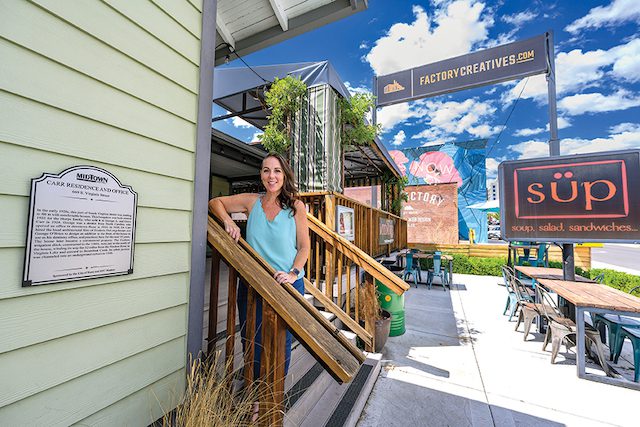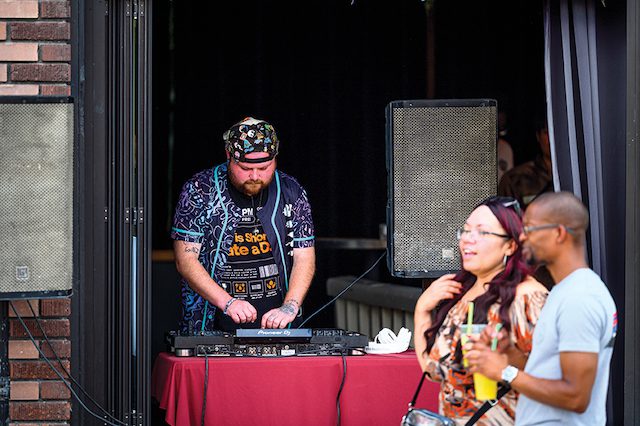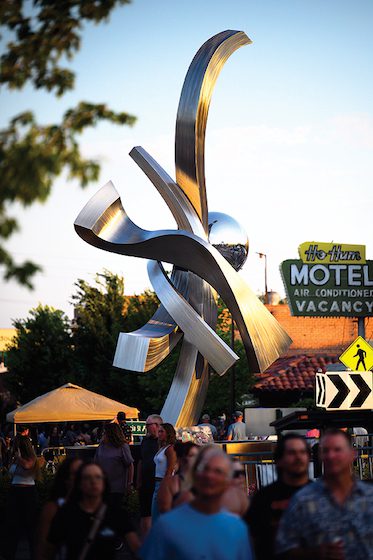
26 Sep Revisiting MidTown Reno
A formerly bustling thoroughfare that fell on hard times enjoys a comeback to its glory years
If you don’t like MidTown now, just wait five minutes, and things could change. The 100-plus-year-old Reno neighborhood started with dental offices, car dealerships and essential services, then in the 1990s and early 2000s turned to strip clubs, sex shops and seediness. Today, amid its resurgence, it’s known as an increasingly well-rounded retail, restaurant, bar and tourism-friendly neighborhood.
MidTown officially spans about 1.2 miles of Virginia Street in central Reno, from Liberty Street in the north to Plumb Lane in the south, with the borders extending a few blocks east and west into the side streets.
If you last visited 20 years ago, five years ago or last weekend, look closer this fall for new historic plaques telling stories of the past and commemorating the neighborhood’s history while marrying the old with the now.
“A leisurely stroll through the neighborhood reveals that the building now known as the Melting Pot World Emporium opened in 1939 as the Dr. Pepper Bottling Company, that the Ponderosa Meat Company had its start in 1947 as Reno Frozen Food Lockers, and that the artesian well still utilized by Brasserie St. James originally supplied the Crystal Springs Ice Company, which completed its Mission-style building back in 1930,” writes historian Alicia Barber in an essay that appears in the Historic Reno Preservation Society’s newsletter, FootPrints.
Barber owns the historic consulting firm Stories in Place LLC. She is also manager and editor of the Reno Historical website, which keeps Renoites grounded in the past through stories and pictures. Last year, a 10-year mission to install historic plaques throughout the district finally launched.
“These plaques—hopefully just the first of many—are the product of an innovative collaboration involving the City of Reno, Regional Transportation Commission Washoe, the MidTown District organization, and more than a dozen business owners and operators,” according to Barber.
The 14 plaques, hanging on various buildings, tell the story of the people, structures and environment when the area was considered the southern edge of town. Barber created a digital map and walking tour on renohistorical.org to help guide people. With the added context of the far past and the near future, a fall journey through MidTown will give people a broader sense of place.
The Olden Days
In the 1920s, the residential neighborhood, sprawling with bungalows and brick houses, transformed into a mixed-use district when Virginia Street was upgraded, becoming a main thoroughfare in and out of town. Like Fourth Street (aka the Lincoln Highway), and even Route 66, the new local and tourist traffic created abundant opportunities.
Motels, shops, restaurants and services popped up, bringing in a bustle of business, according to Barber. In the 1960s, Reno decision-makers decided the car was king and chopped the sidewalks down to widen Virginia Street, a mistake that was later learned.
By 1981, U.S. Route 395 had redirected traffic around the center of town, leading to a decline in pedestrian traffic, vehicle traffic and business. With minimal visitors and difficult-to-traverse sidewalks, MidTown entered a decline long before the 2008 recession.
But by 2010, things had changed again, creating a new story not yet recorded on the plaques.
Near-Past Revival
“The heritage and history of the area drew me to it,” says Kasey Christensen, co-owner of Süp. “I would way rather be in something old with character and a story to it. That’s always really attractive to me.”

Kasey Christensen, co-owner of Süp, poses outside the restaurant by the Midtown District historic plaques
Kasey and Christian Christensen opened Süp, a soup, salad and sandwich restaurant, 18 years ago.
“When we opened in MidTown, we really wanted to be downtown, because that’s what was going on then,” says Kasey Christensen. “The riverwalk was developing in downtown, but we couldn’t find the right space. It was kind of a fluke that we ended up in MidTown. There wasn’t a lot happening right there, and it felt removed from stuff.”
Several years later, the Christensens bought and renovated a building previously known as the Carr family residence and dental practice in the 1920s, and a palm reader business after that. They moved the restaurant in and plan to operate out of the storied structure until the end of their days.
Living Stones Church Pastor Craig Parish, who convinced his leadership and congregation to move to MidTown in 2011, says the area was downright seedy back then. The building they selected had been vacant for a long time after serving as one of Reno’s first supermarkets in the 1940s.

Craig Parish, pastor at Living Stones Church in MidTown, stands in front of mural by Erik Burke that overlooks the church parking lot
“(The church was) right across from one of the biggest strip clubs, and you had porn shops and all these things,” he recalls of the early revival days.
The strip club is still there, though it is now surrounded by sandwich shops and a bicycle repair business. The sole remaining adult store closed and was converted into an antique store recently (somewhat ironically, it was a children’s clothing store before the 1980s).
Both Süp and the church are among the longest-running businesses in MidTown now. Christensen and Parish saw potential for the neighborhood when The Hub, Junkee Clothing Exchange and Chapel Tavern moved into low-rent, dilapidated buildings.
A new MidTown sprouted around them, slowly. People were skeptical at the time, and it took a lot of work to encourage longtime Reno residents to give the neighborhood a chance again. Some people saw the value in starting something new, and others avoided it.
Eventually, the name MidTown with the capital T was created. Both Parish and Kasey Christensen served as presidents of the early MidTown Association volunteer board.
Seeking to build community, similar to what he does inside the church, Parish ran the MidTown Art Walk for 10 consecutive years, starting with the second event in 2009.
The Art Walk encouraged people to visit MidTown by walking up and down the streets to peek inside businesses that temporarily displayed some form of art. It was all voluntary, which means Parish volun-begged people to participate.
“When we started it was two different sectors combining art and commerce,” Parish says. “The first year, maybe 200 people came out to the event, and all we wanted out of it was to get people to come down to this area of Reno to see what it is and create a platform for the arts.”

A DJ entertains passersby at Dancing in the Streets 2025
There was a time when the businesses that didn’t want to participate in the Art Walk tended to close: “The MidTown Art Walk curse,” Parish says.
“What sets MidTown apart a little bit is that it’s a voluntary collaborative effort,” he adds. “People say, ‘I’m not moving for the sake of my own benefit. But I’m moving because I see traction and want to be part of that.’”
The neighborhood began to grow again, just as it had in the early days—a community based on mutual collaboration and success. By the final MidTown Art Walk in 2019, 100-plus businesses participated, and thousands of people filled the tiny sidewalks.
That’s when the Regional Transportation Commission of Washoe County (RTC Washoe) finally set to work rebuilding the streets and sidewalks to revive the pedestrian center that once was. That project finished during the COVID-19 lockdowns, thanks in part to the decrease in vehicle traffic.
What we see now are wide, walkable sidewalks, median-protected streets, foliage, new places to sit and a sculpture-centered roundabout to keep traffic moving.
The New Now
Today, MidTown Reno is a full-fledged 501(c)(6) with an executive director. The Hub, Junkee, Sushi Pier 2, Micano Home and Garden Center, and many others that helped start the MidTown revival 20 years ago have closed, expanded or relocated to other areas around the city, making way for a constant flow of newcomers. But Süp, Living Stones and others remain.

Reciprocity, a 30-foot sculpture created by Hunter Brown, stretches skyward from a gateway roundabout in Reno’s MidTown District
New clothiers, restaurants, bars and shopping experiences have, in some ways, hidden the tumultuous history, for good and bad. The good allows businesses to thrive and focus on building a strong community through new events, programming and platforms without hearkening back to the dark times.
After a three-year hiatus, Parish and other MidTown business owners revived the Art Walk in 2022 in the form of Dancing in the Streets, which attracted more than 30,000 people this past July. The event shuts down Virginia Street, making space for food trucks, craft booths and, most importantly, stages.
“I had been toying with the Dancing in the Streets idea before closing Art Walk,” Parish says. “How do I make it simpler, make it more reproducible?”
Parish wanted to bring diversity to the neighborhood through music. Each side street in MidTown hosted a stage with a different genre of music.
“Music is deeply embedded in cultural systems,” he says. “What if we created an event that highlights unique genres of music, and the stages only play that genre in order to reach across to a diverse array of Reno?”
The bad could mean the public forgets where MidTown came from and how it formed out of people working together to maintain a neighborhood in the past and into the future.
“Depending on your age, you may or may not know where MidTown came from and what it is now,” Parish says.
Barber likes that the historical plaques help us “focus our gaze” and “deepen our knowledge and appreciation of the world around us.”
“By bringing these stories directly to our streetscapes, they can serve a vital role,” she writes, “reinforcing our communal appreciation for these lovely historic buildings and for the generations of people who built, worked and lived in them, in whose footsteps we are privileged to walk.”
A map of the MidTown Reno historical plaque locations can be found at renomidtown.com/about, while a virtual tour of the neighborhood is available at renohistorical.org/tours.
Mike Higdon used to live in MidTown before it was cool, and witnessed the renaissance firsthand. Now he works there and has to remember to try all the new hot bars and restaurants whenever possible to stay in the know.
MidTown Reno Historic Landmarks
• The former Melting Pot World Emporium opened in 1939 as the Dr. Pepper Bottling Company.
• Ponderosa Meat Company had its start in 1947 as Reno Frozen Food Lockers.
• Brasserie St. James originally supplied the Crystal Springs Ice Company starting in 1930.
• Mountain Music Parlor operates in a 1909 Craftsman bungalow.
• Süp restaurant operates inside a 1920s bungalow designed by architect Frederic DeLongchamps to house Carr’s dental office.
• Miguel’s Mexican Food serves food in a converted 1920s home where Miguel Ribera opened his first restaurant in 1959.
• Stella Coffee Company began in 1926 with a Piggly Wiggly grocery store, followed in 1941 by a second building that opened as Heric’s Doughnut Shop.
• Shea’s Tavern, in the same brick building, was designed by Frederic DeLongchamps in 1928 as the Giraudo Apartments.
• The family-owned Sewell’s Supermarket opened in 1959 in the building now known as Statewide Lighting, farther south on Virginia Street.
• Ace Hardware opened in 1948 as a five-and-dime store called Sprouse-Reitz.
• James A. Barnes opened Barnes Radio Service in the spacious 1940 structure, where you can now find Lasting Dose Tattoo & Art Collective and Extra Touch Upholstery. The Radio Service sign is still there.
• Nevada Auto Service took advantage of the corridor’s role as the north-south highway through town, opening in 1929, where the current music venue, Cypress, now operates.
• One of Reno’s oldest plumbing services, Savage and Son, moved out of downtown and into a new building they had constructed in 1940, now home to Michael’s Deli and College Cyclery.
• Peerless Cleaners dry cleaners has been in continuous operation since its opening in 1946.




No Comments